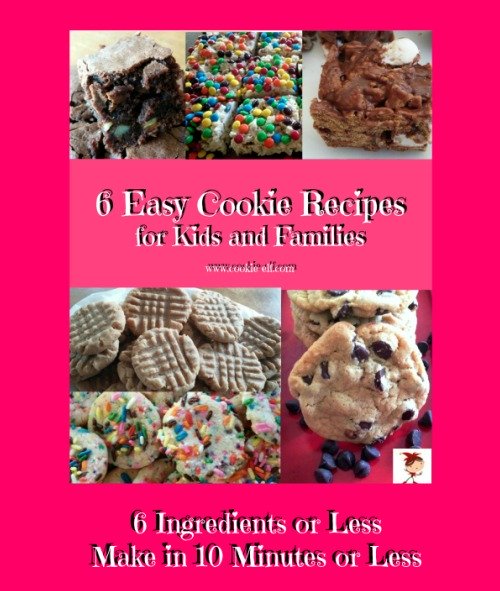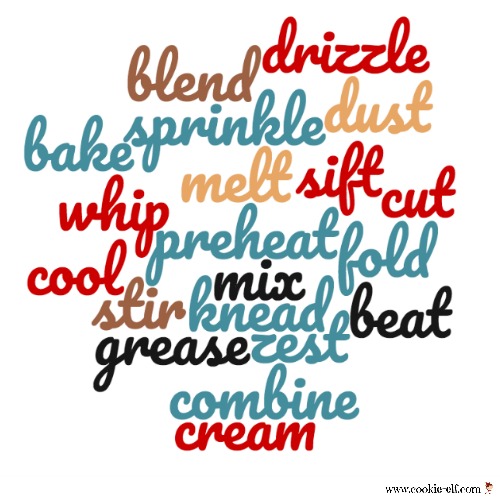Baking Terms to Know When Baking Cookies
Your cookie recipes are filled with baking terms. These terms are simply instructions to follow to make cookies. The Elf is here to help you understand these techniques so you can mix up magic in your own kitchen.
Bake: use dry heat to cook food, usually in an oven.
Beat: stir or
whip with a spoon, electric mixture, wire whisk, or beater to create a smooth
mixture of ingredients. The length and intensity of beating determines how thick
the dough will be. During the beating process, the dough traps air. With
continued beating, air cells break down into smaller sizes, allowing them to
dissolve faster in liquid and thus move more slowly through the dough, creating
a thicker texture.
Blend: lightly mix two or more ingredients together with a spoon, whisk, blender, mixer, or processor until separate ingredients are no longer distinct, but combined make an entirely new mixture. When it comes to baking terms, blending is an even lighter version of mixing. Its goal is to merely incorporate ingredients together.
Combine: mix ingredients together. Among baking terms, "combine" is often used interchangeably in recipes with “blend.”
Cool: reduce temperature until cookies are neither very hot nor very cold, often by allowing them to sit at room temperature.
Cream: mix sugars and fats (butter, margarine, or shortening) with a mixer, large spoon, or beaters until the combination is smooth and velvety in its appearance. Creaming builds small air pockets in the shortening, interspersed with the sugar crystals, to set up the dough structure. (Tips for creaming butter and sugar.)
Cut in: use two knives or a pastry blender to combine cold fats (butter, margarine, or shortening) with dry ingredients (such as flour or sugar) without creaming or mixing air in the ingredients. A well-incorporated cut-in mixture has a crumbly or grainy texture.
Drizzle: let icing fall in drops, particles, or a fine stream over the surface of a cookie or a mixture.
Dust: lightly sprinkle a cooking surface (a pan) or a baked surface (tops of cookies, for instance) with a dry ingredient (such as flour, cornmeal, cocoa, or powdered sugar.)
Fold: gently incorporate a lighter mixture (or additional ingredients) into a previously beaten dough or batter (often a heavier mixture), with a light motion that preserves the air pockets already added to the mixture. Rubber spatulas or large spoons are often used to fold ingredients together by running the edge along the side of the bowl, scooping up portion of the heavier ingredient, and “folding” it over the lighter ingredient onto itself.
Grease: rub pans with a small amount of unsalted shortening or butter, or spray pans with nonstick baking spray, so that when cookie dough is baked it does not stick to the pan. The layer of shortening should be a thin, even coating on the entire baking surface so the pan is shiny.
Knead: work dough with the heels of your hands or with a mixer’s kneading attachment by folding it over and turning it after the dough is pressed. This repeated motion encourages gluten in the flour to stick together and form air pockets, which hold in air and allow dough to rise.
Melt: heat a solid food until it assumes liquid form. (Tips for melting chocolate.)
Mix: distribute ingredients evenly throughout the dough until they are integrated into a new substance. Once mixed, no single ingredient can be individually identified.
Preheat: turn on a cold oven and heat it to the temperature indicated in the recipe before the cookies are placed in it for baking. Most ovens take ten minutes or less to preheat to the proper temperature.
Sprinkle: scatter sugar or toppings over the surface of a cookie or cooking icing.
Sift: place dry ingredients in a sieve and shake it gently to remove lumps and blend the ingredients together.
Stir: mix ingredients together with a spoon using a circular or figure-eight motion.
Whip: incorporate air into batter to increase its volume by beating it a high speed with a mixer, beater, whisk, or spoon.
Zest: grate, scrape, or shred the outer skin of a citrus fruit, using a grater, peeler, or zester.
More Baking Cookies How-Tos
Baking cookies: how-tos make it easy...
How to read and follow a cookie recipe ...
How to modify cookie recipes ...
How to measure dry ingredients ...
Chocolate Chip Cookie FAQs: baking tips for America's favorite cookie ...
Baking Tips for Baking Cookies
Baking cookies tips: The Elf's hints for baking cookies ...
Baking cookies at a high altitude ...
How to scoop cookie dough: 3 ways to try ...
How to spread cookie dough for bar cookies and layer cookies ...
Tips for cutting bar cookies and brownies cleanly and evenly ...
Baking Gear for Baking Cookies
Kinds of baking pans to use when baking cookies ...
Baking sheets: how to choose them for baking cookies ...
Cookie Ingredients
Sugar in cookies: what it does and what kinds to use ...
How to Make Christmas Cookie Icing (AKA Royal Icing) ...
Return from Baking Terms to Know When Baking Cookies
to The Cookie Elf home
Find A Cookie Recipe or Cookie Baking Tip
The Cookie Elf
FREE! 6 Easy Cookies Recipes for Kids and Families
Get your free copy here or when you fill in the form below.





New! Comments
Have your say about what you just read! Leave me a comment in the box below.